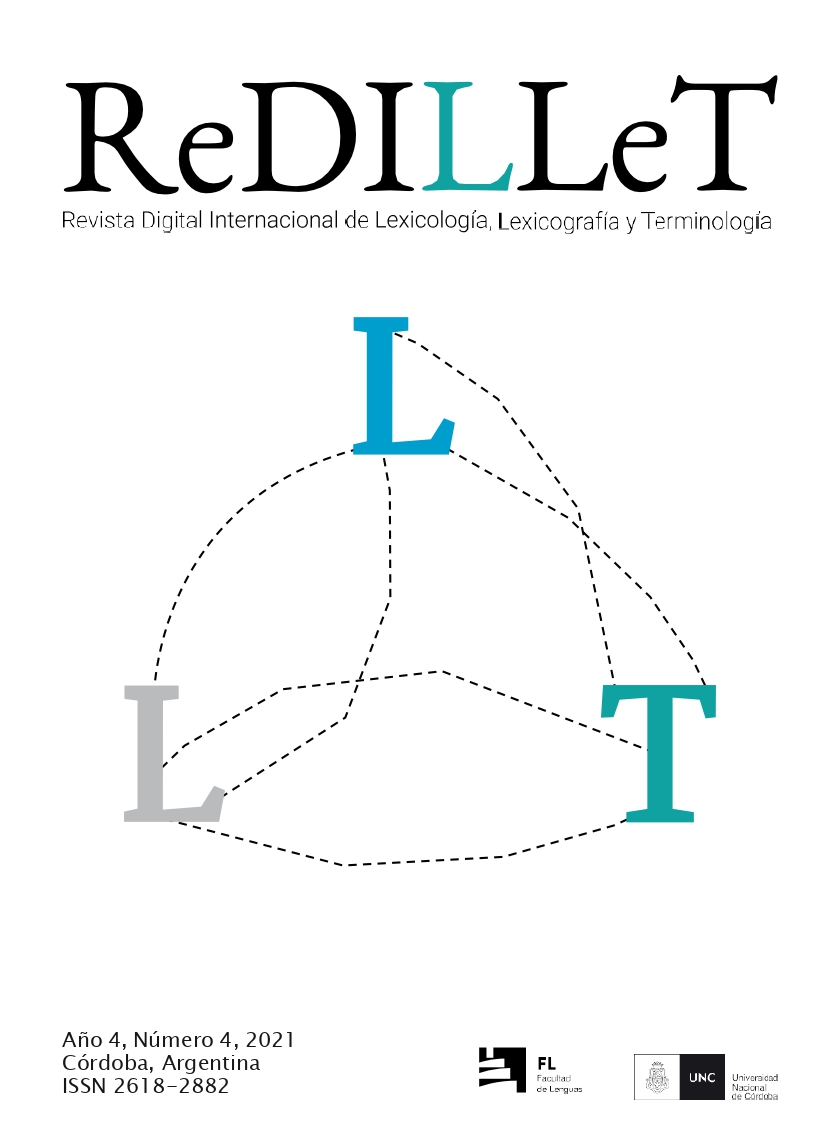Multilingual Color Dictionary: Contextual Implications in Using Color Vocabulary
Palavras-chave:
Lexicography, Colour phrases, Multilingual dictionary, ColoursResumo
This work aims to discuss the universe of colors in relation to the singularities of each chromatic field. Since the use of color universe in language depends on the culture it represents, color phrases illustrate human beings' reality perception. The multilingual dictionary, whose aim is to create colour entries in Portuguese, Italian, Spanish, French and English has been developed at the São Paulo State University (Unesp) as a multidisciplinary academic project, namely Multilingual Color Dictionary (MDC). In this work, we reflect on how the principle of Linguistic Relativism (Arcaini, 1991; Zavaglia, 1996; Lee, 1996) influences the study of color names; we emphasize the lexicon cultural character and reiterate the role of metaphors in the construction of this vocabulary, as well as we emphasize the necessity of considering word's context of use in communication between cultures. By examining entries in Italian > Portuguese and English, and Portuguese > Italian and English, it is possible to classify color vocabulary occurrences as symmetrical or asymmetrical cases depending on specific cultures' influence.
Referências
Álvarez, M. L. O. (2012). Apresentação. In M. L. O. Álvarez (Coord.), Tendências atuais na pesquisa descritiva e aplicada em fraseologia e paremiologia (pp. 12-14). Campinas, SP: Pontes Editores.
Arcaini, E. (1991). Analisi linguistica e traduzione. Bologna: Patron Editore.
Benjamin, W. (1971). La tâche du traducteur. In Œuvres: mythe et violence. Tradução e prefácio de Maurice de Gandillac (pp. 261-275). Paris: Les Lettres Nouvelles.
Berlin, B. & Kay, P. (1969). Basic color terms: their universality and evolution. Berkeley/Los Angeles: University of California Press.
Biderman, M. T. C. (1981). A Estruturação Mental do Léxico. In Estudos de Filologia e Lingüística (pp. 131-145). São Paulo: Edusp.
Colson, J.-P. (2004). Phraseology and computational corpus linguistics: from theory to a practical example. In H. Bouillon (Red.), Langues à niveaux multiples. Hommage au Professeur Jacques Lerot à l'occasion de son éméritat (pp. 35-45). Bibliothèque des Cahiers de l'Institut de Linguistique de Louvain, 113. Louvain-la-Neuve, Peeters.
Fish, S. (1980). Is there a text in this class? The authority of interpretative communities. Cambridge: Harvard University Press.
Fresu, R. (2006). Neologismi a colori: per una semantica dei cromonimi nella lingua italiana. Lingua italiana d’oggi, 3, 153-179.
Jorge, G. et al. (2003). As cores preto no branco: uma análise comparativa. Polifonia, 6, 119-133.
Kövecses, Z. (2010). Metaphor in Culture: universality and variation. (2nd ed.). New York: Cambridge University Press.
______. (2005). Metaphor: a practical introduction. (2nd ed.). New York: Cambridge University Press.
Lakoff, G. & Johnson, M. (2007). Metáforas de la vida cotidiana. Trad. Carmen González Marín. (7. ed.). Madrid: Ediciones Cátedra.
Lee, P. (1996). The Whorf theory complex: a critical reconstruction. Amsterdam/Philadelphia: John Benjamins Publishing Company.
Moraes Filho, W. B. (1995). Uso conotativo das cores em português e em inglês. (Dissertação de Mestrado). Faculdade de Filosofia, Letras e Ciências Humanas, Universidade de São Paulo, São Paulo.
Schogt, H. (1992). Semantic Theory and Translation Theory. In R. Schulte & J. Biguenet (Eds.), Theories of translation: an anthology of essays from Dryden to Derrida (pp.193-203). Chicago: The University of Chicago Press.
Whorf, B. L. (1956). Language, Thought and Reality. In J. Carroll (Ed.), Selected Writings of Benjamin Lee Whorf. Cambridge, United States: The MIT Press.
Zavaglia, C. (1996). Os cromônimos no italiano e no português do Brasil: uma análise comparativa. (Dissertação de Mestrado em Língua e Literatura Italiana). Faculdade de Filosofia, Letras e Ciências Humanas, Universidade de São Paulo, São Paulo.
Downloads
Publicado
Edição
Seção
Licença

Este trabalho está licenciado sob uma licença Creative Commons Attribution-NoDerivatives 4.0 International License.
Aquellos autores que deseen publicar en ReDILLeT aceptan los siguientes términos:
• Los autores conservarán sus derechos sobre el texto entregado y garantizarán a la revista el derecho de primera publicación de su obra. Dicho derecho estará simultáneamente sujeto a la licencia Creative Commons, la cual permite que terceros compartan la obra siempre que
se mencione al autor y al lugar de la primera publicación.
• Los autores realizan una cesión de derechos no exclusivos, lo que implica que la publicación de los artículos en ReDILLeT no impide al autor publicar su texto, a posteriori, en otras revistas u órganos editoriales; asimismo, los autores autorizan que el trabajo sea depositado en repositorios institucionales, como el Portal de Revistas de la Universidad
Nacional de Córdoba o el Repositorio Digital de la Universidad Nacional de Córdoba.



